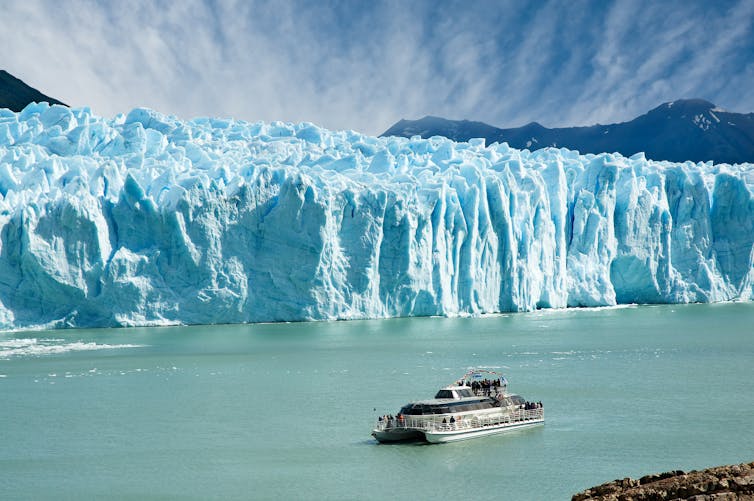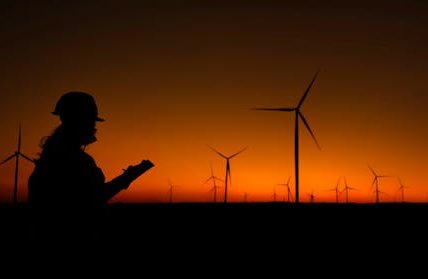Perito Moreno became the world’s first superstar glacier – but now it’s set to disappear
Glaciar Perito Moreno was once considered a rarity: one of Patagonia’s only stable glaciers. But scientists have found the glacier is now in sudden and probably irreversible retreat – and this collapse is a warning for the world’s remaining ice.
Perito Moreno is unusually accessible for such a large and spectacular glacier, with nearly 700,000 visitors a year. Fed by abundant snowfall high up in the Andes, the glacier descends through beech forest to end in Lago Argentino. From here, tourists can get up close and personal on a specially constructed observation deck to watch as icebergs break off the front of the glacier, a process called iceberg calving. Icebergs regularly crack off the ice front and tumble into the turquoise lake below. But now, it’s on the verge of disappearing.
Tourists can take boat trips close to the glacier.
Pablo Caridad / shutterstock
While 90% of Patagonia’s glaciers are shrinking, Perito Moreno has long been the exception thanks to its unique setting. The glacier flows into a narrow channel of Lago Argentino, where it sometimes advances far enough to block one arm of the lake entirely. This forms a natural ice dam, cutting off water flow and causing water to build up behind it. When the pressure becomes too much, the dam bursts.
These ruptures typically happen every few years, but timing can be unpredictable. The glacier been stable up to now and has not been shrinking because it terminates in relatively shallow water where it bumps into the opposite shore.
The south-west portion of the sprawling Lago Argentino. The glacier (bright white, left centre) cuts off one arm of the lake, causing the colour change. The red pin marks the viewing platform.
Google Maps, CC BY-SA
But this is all about to change, as years of reduced snowfall and warmer summers have weakened the glacier. A team of scientists based in Germany and Argentina have tracked its changes over time, and used satellite data, helicopter-mounted radar and lakebed mapping to predict its future behaviour.
In a new study published in the journal Communications Earth & Environment they report that the glacier’s surface has lowered sharply in recent years, and it’s now retreating faster – while the ice itself is flowing more quickly. They believe Glaciar Perito Moreno will never advance again onto the opposite lake shore.
Instead, it is predicted to keep pulling back further into the lake, encountering deeper and deeper water, which will only accelerate its collapse. That’s because glaciers calve more rapidly in deeper water. The authors predict the front of the glacier will soon begin to float, making it even more unstable.
A zoomed in version of the same satellite image shows how Perito Moreno bumps into the opposite shore.
Google Maps, CC BY-SA
The glacier is entering a phase of very rapid and probably irreversible retreat. Tourists may see more dramatic calving in the short term – but they’ll be watching the slow disappearance of one of Patagonia’s iconic natural wonders. Eventually, they’ll be unable to see the glacier at all, as it recedes back into the mountains behind.
A worldwide decline
The retreat of Perito Moreno will represent more than a missed photo opportunity – it’s symptomatic of what’s happening to mountain glaciers around the world. Glaciers are melting faster than ever recorded. Since 2000, mountain glaciers have lost more than 6,500 billion tonnes – or 5% – of their ice. In Iceland, they’ve even held funerals to mark the death of glaciers.
As these glaciers melt, they return their stores of freshwater to the oceans, pushing sea levels higher. If they melted entirely, mountain glaciers would raise global sea-levels by 32cm (just over a foot). We’re some way off that point, but this does mean people living along the coast are likely to feel the impact of melting glaciers.
The effects will also be felt far inland. As glaciers retreat, they can trigger huge floods as lakes backed up behind the ice and their moraine dams suddenly empty when the natural dam bursts. These so-called glacial lake outburst floods are a growing threat to 15 million people worldwide.
Other catastrophic events can be linked directly to glaciers changing. For instance, in May 2025 the Birch Glacier in Switzerland collapsed when a chunk of
nearby mountain broke loose and fell into the ice. The resulting avalanche completely destroyed the village of Blatten. In cases like these, close monitoring and early evacuation save lives.
There are other human consequences related to water supply. Glaciers act as natural freshwater reservoirs; storing winter snow and releasing meltwater through the year. Hundreds of millions of people rely on them for drinking water, farming and sanitation. When the glaciers disappear, so does that steady supply of water.
The projected loss of Glaciar Perito Moreno is not just a problem for Patagonia. It is an icy warning of what lies ahead for the world’s remaining glaciers.
Neil Glasser does not work for, consult, own shares in or receive funding from any company or organisation that would benefit from this article, and has disclosed no relevant affiliations beyond their academic appointment.



